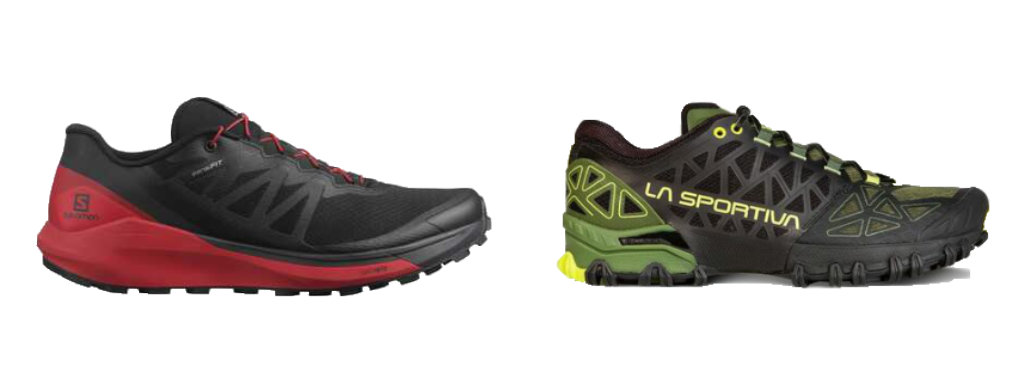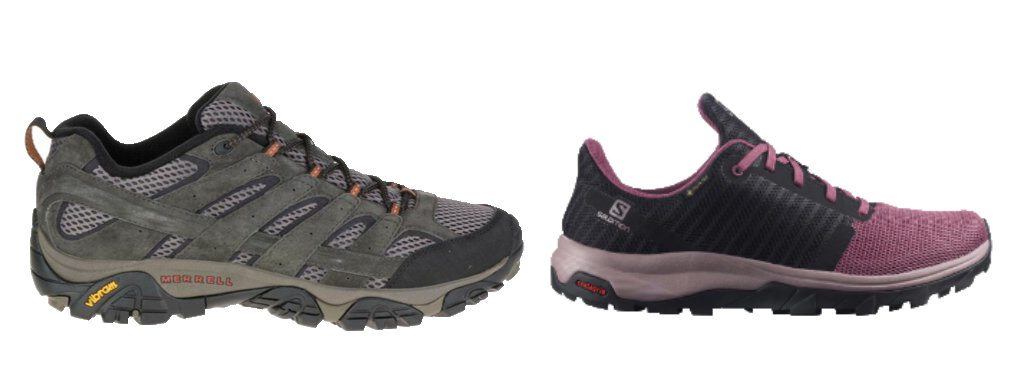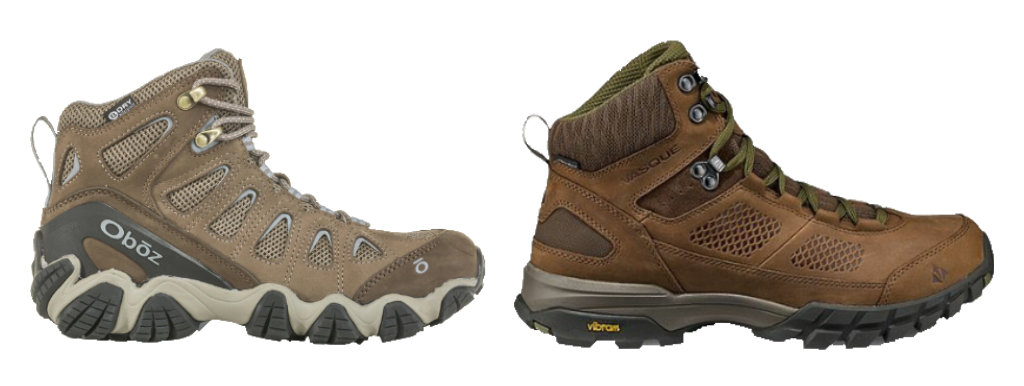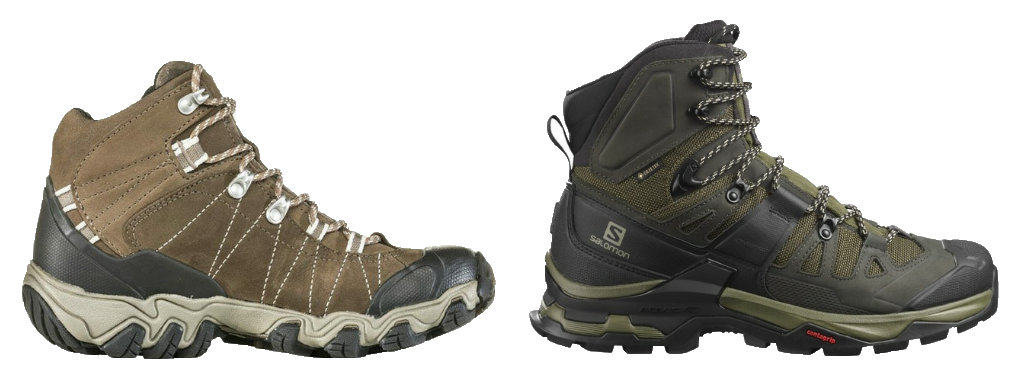The Best Hiking Boots
Posted by AJ ElChaar on Wed Jun 8th 2022
The internet is ripe with “best of” articles, but in reality, what constitutes the best for one person or application isn’t necessarily the best when the circumstances change. In this article we’ll help you better understand the different types of hiking boots and shoes, plus establish how to determine which ones are best for you. Read on below or skip down to the comparisons.
1. What kind of terrain will you encounter?
Nature and trail conditions can be extremely diverse. Maybe you prefer an easy stroll on well maintained, relatively flat trails. Or maybe your cup of tea is pushing yourself to the limit over rugged terrain for days on end while carrying a heavy load. Or maybe you’re somewhere in the middle. Generally speaking, stiff and supportive footwear like backpacking boots are better for rugged terrain, whereas lighter flexible footwear will be more comfortable on mild terrain.
2. What’s your style of hiking?
Are you the type who wants to set speed records, moving fast with minimal lightweight gear? Are you more interested in being comfortable and prepared for any situation? Do you just want to relax and have fun on the trail? Your style of hiking will likely lend itself to one type of hiking boot or shoe over another. Many thru-hikers on the Appalachian Trail or PCT opt for the lightest footwear that reasonably makes sense - oftentimes trail running shoes. Their objective is to move as fast and light as possible in the months they spend out on the trail. Maybe you’re a hunter who needs to be able to haul in extra gear and is willing to pay a weight penalty for a more supportive boot. Or maybe you’re a day hiker looking for something that is more of an all-around choice for a variety of outdoor activities.
3. What’s your fitness and flexibility level?
I’m not talking about how often you go to the gym, or if you can run a 5-minute mile and bench press 300lbs… more like “how strong are your ankles and feet.” If you don’t spend a lot of time traversing rocky or uneven terrain, you might benefit from more supportive footwear. If you put in 15+ miles per week hiking and have relatively strong ankles and feet, you might be just fine with something less supportive.
Hopefully now you’re thinking about what you want out of a hiking boot instead of what some dude on a Youtube video says you and everyone else in the universe are supposed to use. So here's a quick breakdown of what characterizes the different types of hiking boots and shoes.
Types of Hiking Boots & Shoes
Trail Running Shoes

This would be the lightest weight, most flexible, and most breathable class of hiking footwear. They will give you better traction and support than standard sneakers, so they are much better for use on the trail. If you’re looking to set blazing fast trail times, or just prefer the fit and feel of a sneaker, trail running shoes are for you.
Pros: Lightest weight, most breathable, maximum mobility & flexibility
Cons: Least support and protection, least durable
Shop: Men's Trail Running Shoes | Women's Trail Running Shoes
Hiking Shoes

Hiking shoes are one step up from trail running shoes in terms of support and durability. They are also usually a little heavier and less nimble. Hiking shoes usually share many features in common with over-the-ankle hiking boots, except they do not come over your ankle. The way they are able to offer more stability is through stiffer sole construction that acts to stabilize and support your foot more than a trail running shoe would. Hiking shoes are a great choice for someone who is simply trying to leisurely enjoy their time in the outdoors and plans mostly fair-weather excursions on mild to moderate trails.
Pros: Lightweight, breathable and waterproof options available, good mobility & flexibility, modest support
Cons: Not as supportive as mid height boots, not ideal for 4-season adventures in mud and snow
Shop: Men's Hiking Shoes | Women's Hiking Shoes
Hiking Boots

Hiking boots encompass nearly all over-the-ankle hiking boots. Generally these will have comparable support to hiking shoes, but with added protection around the ankle. This means that they are usually a little heavier than a hiking shoe of the same construction, but they also offer a little more support. Additionally, the higher height means that hiking boots are a better choice for year-round adventure and excursions where you may encounter foul weather, mud, and snow. Hiking boots are probably the best choice if you want one all-around footwear item for everything outdoors - they’re not the best at any one thing, but they are pretty darn good at most.
Pros: Supportive without being too heavy or stiff, versatile for lots of weather and terrain conditions, reasonably durable.
Cons: Not as light as lower height shoes, may require more break-in before regular use
Shop: Men's Hiking Boots | Women's Hiking Boots
Backpacking Boots

Backpacking boots are basically hiking boots with upgraded features in terms of durability and support. They share many similarities, but will usually be noticeably stiffer in all areas - flexion, torsion (twisting), and ankle. This translates into a piece of footwear that can handle more abuse in terms of terrain and the amount of weight you’re carrying before it begins to degrade in performance. We generally recommend backpacking boots for people looking for the highest level of durability and support.
Pros: Most support, suitable for hiking in all terrain and weather conditions, most durable
Cons: Generally the heaviest and stiffest type of hiking boot, most require an extensive break in process before regular use.
Shop: Men's Backpacking Boots | Women's Backpacking Boots
Honorable mention: Mountaineering Boots
We won’t go into a lot of detail about mountaineering boots, because they are usually a much more specialized piece of footwear. But they bear mentioning because some lighter-duty 3-season mountaineering boots blur the lines with some of the heavier duty backpacking boots. If you plan on primarily, or exclusively hiking high peaks and very rugged terrain, then some of the lighter duty mountaineering boots might be worth considering too. Keep in mind that mountaineering boots are designed with aspects of technical rock and ice climbing in mind, so using them as your everyday hiking boot would be sort of like using a Mack truck as your daily commuter car.
Shop: Mountaineering Boots
Honorable Mention: Hiking Sandals, minimalist shoes, and moccasins
There are some brands and styles of sandals and other minimalist footwear that are oriented toward hiking and outdoor pursuits. These are great shoes for certain conditions and types of hiking, but for most people, they will overall lack the versatility expected from a hiking boot or shoe. For example, they’ll be great for summertime excursions to the local pond, lake, or river, but would they be your first choice if the weather suddenly turns on an early spring or late fall hike when you’re miles away from camp or the car? Maybe that’s fine in your book, but if not you should definitely consider other types of footwear.
So which type of hiking footwear is right for you?
Some avid hikers will have several pairs of boots and shoes and will use them each for different applications. If you’re that person, you probably already have ideas for what your next addition will be. But if you’re trying to decide on one pair to kind of do everything, carefully consider what you will get the most use out of. All of the above types of footwear are completely fine for the vast majority of the hikes most people do, so go with the one you think you’ll use the most - not the “just in case” pair. Finally, if you really truly can’t decide, we recommend trying on a few pairs of mid and low height hiking boots - they will be the most versatile. And if after a few months of use you realize you want another pair for a more specialized application you can always add to your quiver.
Links:

